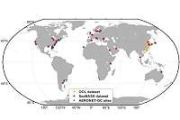IUPAC has officially approved the name copernicium, with symbol Cn, for the element of atomic number 112.
Priority for the discovery of this element was assigned, in accordance with the agreed criteria, to the Gesellschaft für Schwerionenforschung (GSI) (Center for Heavy Ion Research) in Darmstadt, Germany. The team at GSI proposed the name copernicium which has now been approved by IUPAC. Sigurd Hofmann, leader of the GSI team stated that the intent was to "salute an influential scientist who didn't receive any accolades in his own lifetime, and highlight the link between astronomy and the field of nuclear chemistry."
The name proposed by the Gesellschaft für Schwerionenforschung (GSI) lies within the long tradition of naming elements to honor famous scientists. Nicolaus Copernicus was born on 19 February 1473, in Torún, Poland and died on 24 May 1543, in Frombork/Frauenburg also in Poland. His work has been of exceptional influence on the philosophical and political thinking of mankind and on the rise of modern science based on experimental results. During his time as a canon of the Cathedral in Frauenburg, Copernicus spent many years developing a conclusive model for complex astronomical observations of the movements of the sun, moon, planets and stars. His work published as “De revolutionibus orbium coelestium, liber sixtus” in 1543 had very far reaching consequences. Indeed the Copernican model demanded major changes in the view of the world related to astronomy and physical forces and well as having theological and political consequences. The planetary system introduced by Copernicus has been applied to other analogous systems in which objects move under the influence of a force directed towards a common centre. Notably, on a microscopic scale this is the Bohr model of the atom with its nucleus and orbiting electrons.
The Recommendations will be published in the March issue of the IUPAC journal Pure and Applied Chemistry and is available online at Pure Appl. Chem., 2010, Vol. 82, No. 3, pp. pp 753-755 (doi: 10.1351/PAC-REC-09-08-20). Priority of claims to the discovery of the element of atomic number 112 was determined by a joint working party of independent experts drawn from the International Union of Pure and Applied Chemistry (IUPAC) and the International Union of Pure and Applied Physics (IUPAP). The group’s report was published in July 2009, Pure Appl. Chem., 2009, Vol. 81, No. 7, pp. 1331-1343 (doi: 10.1351/PAC-REP-08-03-05). The Joint Working Party will issue a second report, dealing with claims for the discovery of elements with atomic numbers in the range 113 to 118, in the near future.
IUPAC was formed in 1919 by chemists from industry and academia. For more than 90 years, the Union has succeeded in fostering worldwide communications in the chemical sciences and in uniting academic, industrial and public sector chemistry in a common language. IUPAC is recognized as the world authority on chemical nomenclature, terminology, standardized methods for measurement, atomic weights and many other critically evaluated data. More information about IUPAC and its activities is available at www.iupac.org.
For questions, contact Dr. Terrence Renner, Executive Director, at <>.

















































